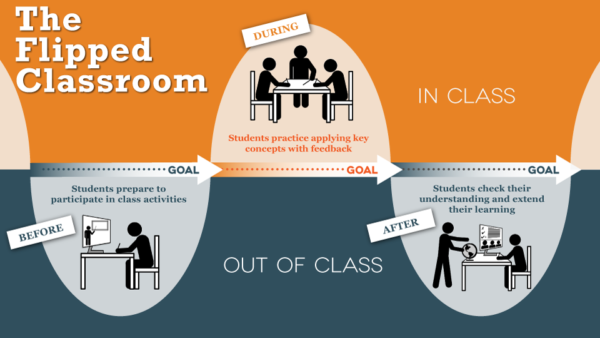
Flipped Learning Model
When we think of the word flip, we might picture our favorite summertime shoe, doing front and backflips off a diving board, or ‘flipping’ a house for an investment. But what is flipped learning? And how is it implemented at Williamsburg Christian Academy?
The flipped learning model uses technology to provide the initial exposure of new concepts in video form for homework and reserves the higher level of cognitive work for the classroom with learning facilitator and peer support. In the traditional classroom, teachers introduce concepts through a lecture format that consumes classroom time, leaving students to work on the high levels of cognitive and difficult tasks at home without teacher support. Studies have shown that the traditional approach often results in low student engagement and productivity, along with limited time with students. Students absent for illness and extracurricular activities add to the frustration. These students lag behind others, missing the lecture portion of the instruction. Flipped classroom students are motivated to apply, analyze, evaluate, and synthesize knowledge when working in the classroom with teachers and peers. This evidence-based approach is fully accepted by educational experts worldwide. And teachers are transformed into learning facilitators, guiding students towards ownership of their own education.

Four Reasons Why Flipped Classrooms Produce Better Learning
Strengthens Student-Teacher Relationship
The flipped classroom cultivates relationships; each child is known and taught more strategically. With the added interaction with each student and small groups, learning facilitators have a clear understanding of what each student knows and doesn’t know. Learning facilitators intentionally observe the process of learning to identify obstacles and misconceptions. This learning model prioritizes evidence-based practice that replaces meaningless busywork and teaching to the test
Less Anxiety
Flipped learning decreases student anxiety and minimizes the struggle over homework. Viewing a lesson is easy and the accountability and expectations for completion are clear and not complicated. Students are no longer overloaded with homework as learning facilitators know exactly how long it will take for the student to view the video lesson.
Easier Parental Involvement
Flipped learning minimizes homework battles. How often have you attempted to help your child with homework to have them respond, "That’s not how my teacher taught me." With flipped learning, parents partner with learning facilitators by viewing the actual material and learn how the concept was taught. This provides better support for students without feeling the pressure to be the teacher at home.
Students Pace Their Own Learning
The flipped learning model is a gateway for individualized and mastery learning in which students can work at their own pace. Students are able to pause and rewind lessons as many times as needed without embarrassment. This decreases stress and anxiety for students when lessons are delivered too quickly.

Flipped Learning Model
When we think of the word flip, we might picture our favorite summertime shoe, doing front and backflips off a diving board, or ‘flipping’ a house for an investment. But what is flipped learning? And how is it implemented at Williamsburg Christian Academy?
The flipped learning model uses technology to provide the initial exposure of new concepts in video form for homework and reserves the higher level of cognitive work for the classroom with learning facilitator and peer support. In the traditional classroom, teachers introduce concepts through a lecture format that consumes classroom time, leaving students to work on the high levels of cognitive and difficult tasks at home without teacher support. Studies have shown that the traditional approach often results in low student engagement and productivity, along with limited time with students. Students absent for illness and extracurricular activities add to the frustration. These students lag behind others, missing the lecture portion of the instruction. Flipped classroom students are motivated to apply, analyze, evaluate, and synthesize knowledge when working in the classroom with teachers and peers. This evidence-based approach is fully accepted by educational experts worldwide. And teachers are transformed into learning facilitators, guiding students towards ownership of their own education.

Four Reasons Why Flipped Classrooms Produce Better Learning
Strengthens Student-Teacher Relationship
The flipped classroom cultivates relationships; each child is known and taught more strategically. With the added interaction with each student and small groups, learning facilitators have a clear understanding of what each student knows and doesn’t know. Learning facilitators intentionally observe the process of learning to identify obstacles and misconceptions. This learning model prioritizes evidence-based practice that replaces meaningless busywork and teaching to the test
Less Anxiety
Flipped learning decreases student anxiety and minimizes the struggle over homework. Viewing a lesson is easy and the accountability and expectations for completion are clear and not complicated. Students are no longer overloaded with homework as learning facilitators know exactly how long it will take for the student to view the video lesson.
Easier Parental Involvement
Flipped learning minimizes homework battles. How often have you attempted to help your child with homework to have them respond, "That’s not how my teacher taught me." With flipped learning, parents partner with learning facilitators by viewing the actual material and learn how the concept was taught. This provides better support for students without feeling the pressure to be the instructor at home.
Students Pace Their Own Learning
The flipped learning model is a gateway for individualized and mastery learning in which students can work at their own pace. Students are able to pause and rewind lessons as many times as needed without embarrassment. This decreases stress and anxiety for students when lessons are delivered too quickly.
